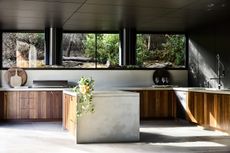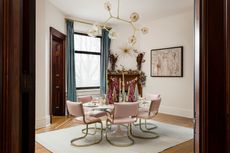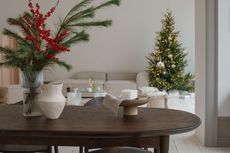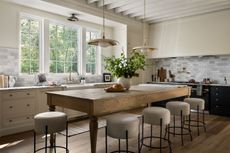More Guests Than Matching Dinnerware? How Tablescaping Pros Make Sure Tables Still Look Beautiful
If you're hosting a dinner party and are struggling to cobble together enough dinnerware, these tips from the tablescaping pros are bound to help you out
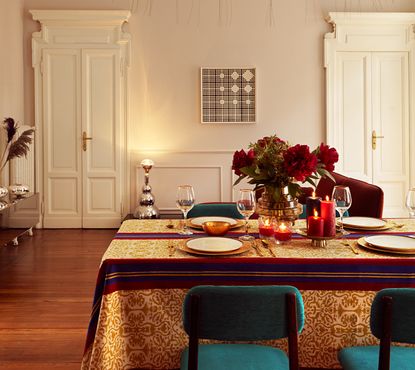

Hosting a dinner party can be a pressured task at the best of times, but when it comes to setting the table on the big day and you find you're low on dinnerware, you might regret sending out all those invitations. One option is to frantically message your guests on the big day to ask them to bring plates or spare dessert spoons, or even a last-minute dash to the shop for a pack of not-so-aesthetically pleasing paper plates. But we think the best solution is to think outside the box and embrace the problem as a challenge.
A little creativity goes a long way in the dining room, insist the designers at Atelier Saucier, Nikki Reed and Staci Inspektor. ‘There's always space at the table for one or three more! The secret sauce? Nailing the art of an eclectic yet polished tablescape. It's about creating a welcoming atmosphere without overcomplicating things.’ To help you, we've spoken to the tablescaping pros and come up with some brilliant solutions.
1. Bookend the table
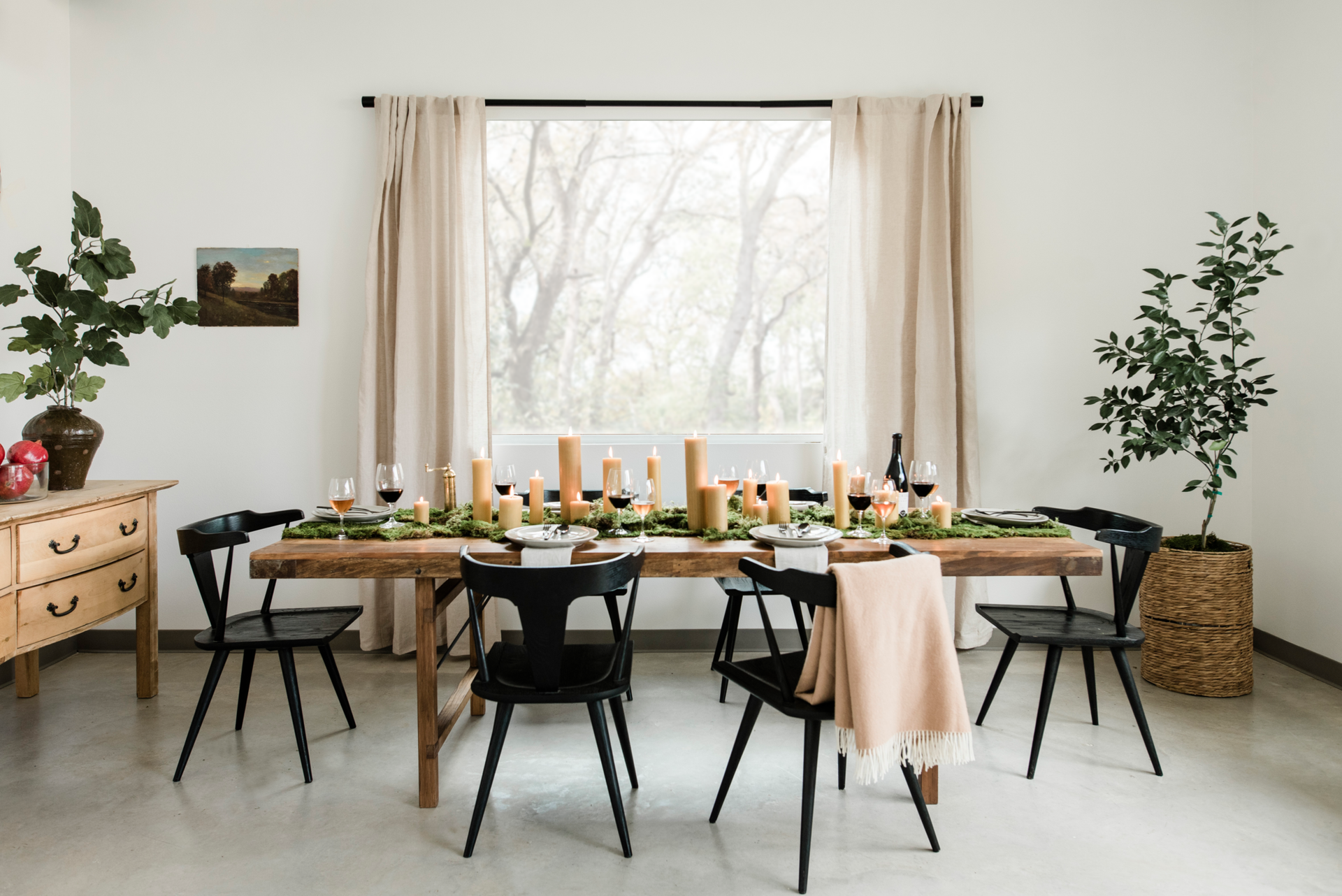
If you're lacking just one or two table settings, make a virtue out of the problem, suggests interior designer and luxury linens stylist, Liz Barbatelli.
'If down by just two settings and you're hosting on a rectangular versus a round dining table, then the two end seats – typically reserved for the host and the hostess – should be set with their linens and dinner plates, adlibbing as the bookends for the table.' This helps make your lack of dinnerware look deliberate and can save you from the last-minute dash to the shops.
2. Or embrace the mix-and-match look

Long gone are the days when everything on the dining table had to be perfectly matching and neat. Instead, we're embracing the mix-and-match style for a look that feels cozy, rustic and homely. If you don't have enough matching plates and cutlery, embrace the look and you might be surprised by how much you like the results. 'Be super eclectic and mix up the entire look with alternating patterns and colors that come together in an elegant and surprisingly connected style,' says Liz.
‘Relax and enjoy the process,' add Nikki and Staci, founders of Atelier Saucier. 'Experiment with the allure of mixing and matching, table linens, glassware and plates. Consider anchoring your choices with a bold pattern or standout dining room color, it sets the tone beautifully!’
To bring everything together and make sure the look isn't too disjointed, draw inspiration from colors on a printed runner or large serving dish, and incorporate them into your choice of linens. 'Stick to hues within the same color family for a cohesive, monochromatic look, or get playful by layering additional prints and colors,' say Nikki and Staci. 'And don’t forget about the power of florals. A scattering of bud vases can tie together your color story seamlessly.'
3. Or alternate your dinnerware

If you're not tempted to go full-on mix-and-match mode, alternating is another great dining table trend to solve the problem of a lack of dinnerware. ‘When you have more guests than dinnerware available, a clever trick is to use alternating sets of dinnerware or flatware at each place setting,’ says Lauren Lerner, CEO and founder of Living with Lolo. ‘This not only solves the problem but also creates an intentional and purposeful aesthetic.’
4. Alter the menu to accommodate what dinnerware you do have

Finger food anyone? Smaller menus might suit a small dining room. Why not try and alter the menu to accommodate what you do have, rather than planning an elaborate five-course meal only to later find out you're down a few plates.
Traditional table setting styles include cutlery for every course, not to mention three different glasses for whatever wine you're having, as well as water. But really, this is quite a formal place setting that isn't totally necessary. Think outside the box and serve up a more modern feast. Go for the canape course which helps fill your guests up and adds a sense of occasion, or include platters of finger food, or mini bowls if you have a surplus in your home.
'Another idea is to set up a buffet sideboard or a console table with an array of dinnerware and linens and have the table come together organically as guests seat themselves,' says Liz. 'At the end of the day, don’t worry about it too much – family and friends are simply happy to be together celebrating the holiday and will not be fussing over matching plates.'
‘Setting up a buffet for food is also good as you do not have to fill up the table with added dishes,’ points out Alexandra Killion of Alexandra Killion Interiors.
5. Create socializing stations

Stray away from the traditional style dining room set-up, moving the focus of the dinner party away from the table. This is a way to distract from the fact that you're lacking cutlery or plates. ‘Experimenting with different seating arrangements also fosters conversation,' says Chelsea Thowe, lead designer at Forge & Bow.
'Arrange chairs in clusters to create intimate corners, and have more spacious areas for larger groups. Place side tables and console tables in areas where people will be gathering so there is always a place for people to set down their drinks or plates.'
3 Trending Dinnerware Sets For a Stylish Dinner Party

Material: Stoneware
Price: $82.49

Material: Stoneware
Price: $184

Material: Stoneware
Price: $58.43
Be The First To Know
The Livingetc newsletter is your shortcut to the now and the next in home design. Subscribe today to receive a stunning free 200-page book of the best homes from around the world.

Oonagh is a content editor at Livingetc.com and an expert at spotting the interior trends that are making waves in the design world. Writing a mix of everything and everything from home tours to news, long-form features to design idea pieces on the website, as well as frequently featured in the monthly print magazine, she's the go-to for design advice in the home. Previously, she worked on a London property title, producing long-read interiors features, style pages and conducting interviews with a range of famous faces from the UK interiors scene, from Kit Kemp to Robert Kime. In doing so, she has developed a keen interest in London's historical architecture and the city's distinct tastemakers paving the way in the world of interiors.
-
 These 12 Best Table Lamps for Your Desk — Perfect Glows for a Creative Home Office
These 12 Best Table Lamps for Your Desk — Perfect Glows for a Creative Home OfficeThe best table lamps for your desk is have a soft, targeted glow. Elevate your WFH set-up with these stylish picks endorsed by Style Editor Brigid Kennedy
By Brigid Kennedy Published
-
 The Nespresso VertuoPlus is 30% Off for President's Day, and it's Kim Kardashian's Coffee Maker of Choice
The Nespresso VertuoPlus is 30% Off for President's Day, and it's Kim Kardashian's Coffee Maker of ChoiceThis sleek and stylish coffee maker was spotted in Kim's home bar, and you can currently save $60 if you buy yours from Amazon
By Lilith Hudson Published
-
 How to Replant a Live Christmas Tree for Flourishing Evergreen Foliage All Through the Year
How to Replant a Live Christmas Tree for Flourishing Evergreen Foliage All Through the YearExtend the magic of Christmas into the new year by planting your tree in your yard
By Lilith Hudson Published
-
 5 Tips to Tackle a Deep Clean in the Post-Christmas Slump – 'They're Fast and Effective!'
5 Tips to Tackle a Deep Clean in the Post-Christmas Slump – 'They're Fast and Effective!'Professional organizers reveal their expert advice on how to tackle the Christmas clear up
By Amy McArdle Published
-
 This is How Professional Organizers Take Down Christmas Decorations – 'It's the Most Effective Method Out There!'
This is How Professional Organizers Take Down Christmas Decorations – 'It's the Most Effective Method Out There!'Store your Christmas decorations in the most efficient way possible with this 5-step guide from the experts
By Amy McArdle Published
-
 Tradition Says You Should Take Your Christmas Tree Down on This Specific Date if You Want Good Luck
Tradition Says You Should Take Your Christmas Tree Down on This Specific Date if You Want Good LuckTo avoid bad fortune in 2024, this centuries-old practice says you might want to wait a while longer before you dismantle the Christmas tree
By Lilith Hudson Published
-
 5 Mistakes to Avoid When Storing Christmas Ornaments – 'It Makes Next Year's Decorating so Much Easier!'
5 Mistakes to Avoid When Storing Christmas Ornaments – 'It Makes Next Year's Decorating so Much Easier!'These professional organizers reveal the common Christmas storage mistakes that you'll grow to regret
By Amy McArdle Published
-
 How to Care for a Christmas Rose to Keep it Blooming All Season – 'It's the Ultimate Winter Plant!'
How to Care for a Christmas Rose to Keep it Blooming All Season – 'It's the Ultimate Winter Plant!'These experts reveal how to get the most out of your festive flower through Christmas and beyond
By Amy McArdle Published
-
 12 Days of Decluttering - Tackle One of These Areas Each Day for a Clutter-Free Home Come Christmas Day
12 Days of Decluttering - Tackle One of These Areas Each Day for a Clutter-Free Home Come Christmas DayExperts suggest prioritizing these 12 spaces ahead of the 25th
By Amy McArdle Published
-
 How to Fix a Limp Christmas Cactus For Bright and Flourishing Festive Foliage
How to Fix a Limp Christmas Cactus For Bright and Flourishing Festive FoliagePlant experts reveal the important steps to take to turn the health of your Christmas cactus around
By Amy McArdle Published



